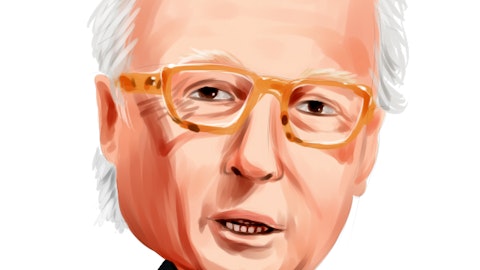Camille Bonnel: Okay. That’s helpful. And Gregg, I’d like to get your latest thoughts on how you’re thinking about your floating rate debt strategy. I know you’ve spoken to in the past about being 20% as your target level, but with signs of the strengthening consumer and a robust job market. I think there’s risk that the Fed continues to keep rates high, if not increase them. So do you still plan to keep this level as a target? Or what’s your latest thoughts here?
Gregg Adzema: Sure. So you’re right. Our long-term target for floating rate debt as a percentage of total debt is right around 20%. And that’s where it is today, 21% as of year-end. We arrived at that level — let me take a step back. That’s consistent with, by the way, with the median curve, the office space as well. Some are at 0, but some are much higher. If you take a look at the 20-odd office companies out there, the average is right around 20%. So we’re not high or low relative to our peers. That being said, we do have some benefit of having some floating rate debt on our books, not the least of which is that floating rate debt is oftentimes prepayable without a penalty. And when we’re looking at our kind of sources and uses, we want to be able to be opportunistic.
And so having the option of repaying some debt without penalty, we think, is a pretty powerful tool to have. And so that’s what we have that, among other reasons, is why we have some floating rates has been on our books. So I don’t think you’re going to see it move materially from 20%. It hasn’t in the past in the 12 years I’ve been here, it’s always been right around 20%. I think it will remain there. It really is only comprised of 3 pieces of debt, it’s our credit facility. It’s the term loan that we just issued, and it’s the new health construction on. That’s it, but it solves for 20%. And it’s something that we keep an eye on as well, and I don’t see changing going forward necessarily.
Camille Bonnel: Okay. Thank you for taking my questions.
Operator: Our next question will come from Michael Lewis with Truist. You may now go ahead.
Michael Lewis: Great, thank you. So Richard gave great detail on how concessions looked high during the quarter because of the Apache lease in Houston, but the cost for the rest of the portfolio were actually very reasonable. It looks like maintenance CapEx was a little elevated, too. I don’t know if that was also related to Houston. But my question is more broadly where net effective rents are and where they might be going in your markets and for your buildings. You consistently have very strong rent spreads. But do you think it’s possible for office net effective rents to grow over the next, pick your time period given what we all see for physical occupancy and tech layoffs and all these apparent challenges for the industry.
Colin Connolly: Good morning, Michael, it’s Colin. I’d say our experience over the last couple of years is there’s been quite a bit of inflation in pressure on things like TIs and so our overall concessions during that period have escalated, but we’ve been able to drive kind of face rents to offset that. And so we have been able to grow net effective rents I think we’re at a point in time, obviously, where the economy is softening, potentially cycling down. And so as we look forward, I think it’s still too early to tell. I’d say the leases that we’re working on today, we’ve characterized net effective rents is kind of flattish, not growing them perhaps like we were last year, but not yet coming in. But typically, in economic cycles, you do see net effective rents soften.





